-

(left) A patient, presumably Dave Lee, sits upright, smiling in a hospital bed. Two nursing staff stand to either side of Lee and look at them, smiling. The words "DAVE LEE" can be seen at the bottom and top right corner of the photograph.
(right) This article contains information on the Loyola-sponsored 108th Army General Hospital, which established its headquarters at The Hospital Beaujou in Clichy, France in October 1944. Many of the staff, comprising doctors, dentists, nurses and enlisted men, were drawn from Loyola's medical program and affiliated hospitals.
*This collage was created using images from various sources (see 'Source' for more information).
-

A patient, presumably Dave Lee, sits upright, smiling in a hospital bed. Two nursing staff stand to either side of Lee and look at them, smiling. The words "DAVE LEE" can be seen at the bottom and top right corner of the photograph.
-

This article contains information on the Loyola-sponsored 108th Army General Hospital, which established its headquarters at The Hospital Beaujou in Clichy, France in October 1944. Many of the staff, comprising doctors, dentists, nurses and enlisted men, were drawn from Loyola's medical program and affiliated hospitals.
-

A short Loyola News article discusses a series of basketball games planned for the 1944-45 season. The sport had been dropped around 1942 due to the war. This new, informal team was organized by athletic director Rev. James T. Hussey, S.J., would be coached by the director of the Physical Education program, Alex Wilson, and have ten members, nine of whom were freshmen. They played against Concordia college, Northern Illinois State Teachers College, Elmhurst college, and Wheaton college.
-
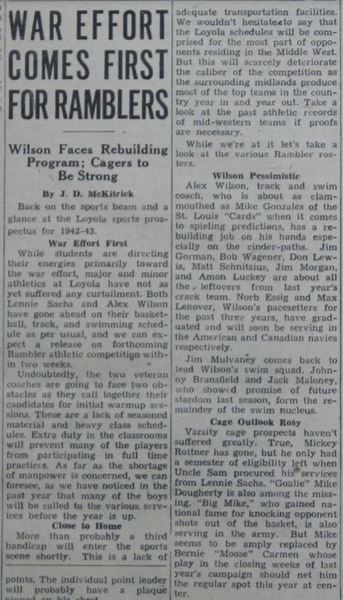
This Loyola News article discusses the continuing basketball, track, and swimming activities at Loyola during WWII. Lack of "seasoned material" due to students serving in the armed forces was a challenge, as well as remaining students had "extra duty in the classrooms" that took up much of their time, and students expected that more of their players would be drafted by the end of the year. Few nearby schools had enough students for teams, which meant Loyola would have trouble finding teams to play against.
Similarly, only a few members of the track team remained.
-

This article covers the Radio Workshop's achieving independent student organization status formally on October 17, 1949. Information on the formal organizational structure is also included. The article also carries an image of Herbert Percil, an Arts senior, who had been elected president of the organization.
-
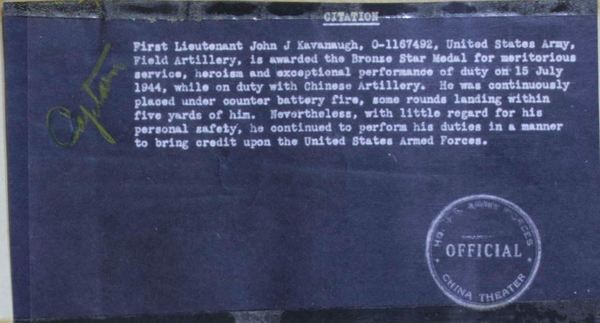
This is a blue copy with white writing of a Citation for First Lieutenant John J. Kavanaugh. It is stamped with an official seal of the army for the China Theater.
"First Lieutenant John J. Kavanaugh, 0-1167492, United States Army, Field Artillery, is awarded the Bronze Star Medal for meritorious service, heroism and exceptional performance of duty on 15 July 1944, while on duty with Chinese Artillery. He was continuously placed under counter battery fire, some rounds landing within five yards of him. Nevertheless, with little regard for his personal safety, he continued to perform his duties in a manner to bring credit upon the United States Armed Forces."
-
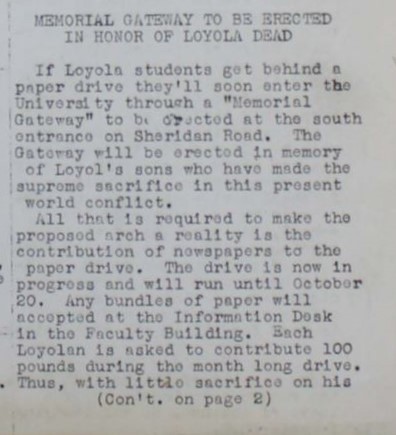
This article talks about the plans for a memorial gateway in honor of Loyola's war dead, which was to be erected at the "south entrance on Sheridan Road". The article also carried a call for student contributions to the paper drive that would go toward funding the gateway.
-

This article, dated December 15 1949, covers the changes that have occurred at Loyola News over the past 25 news. Some of the changes detailed include the shifts in the format of the newspaper and the impact of the draft during the Second World War on its staff and publication schedule. An image of the very first issue of Loyola News is also included.
The article also includes an image of the newsroom, showing four Loyola News staff members engaged in various forms of work. The caption reads: "Activity runs rampant at the LSC newsroom as photog snaps pic. At the copy table are Chris FitzGerald, editor, and Ted Johnson, copy editor, while Art Bilck, acting news editor, and John Blais, rewrite man work at rear desks."
-
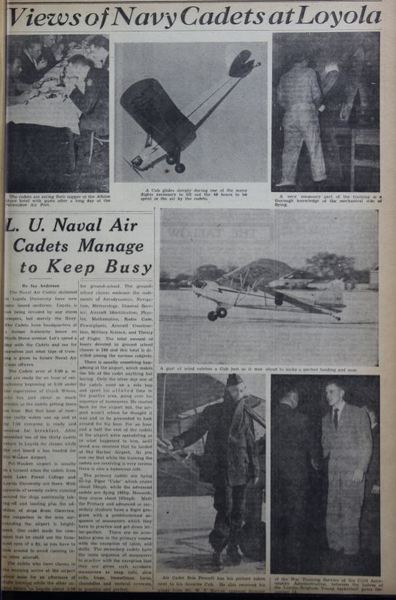
This article describes the activities of the Naval Air Cadets stationed at Loyola, including many photos of them eating, socializing, and flying planes. They were stationed at the school and did their exercises at "Pal-Waukee" airport. Palwaukee airport is now called Chicago Executive Airport.
-
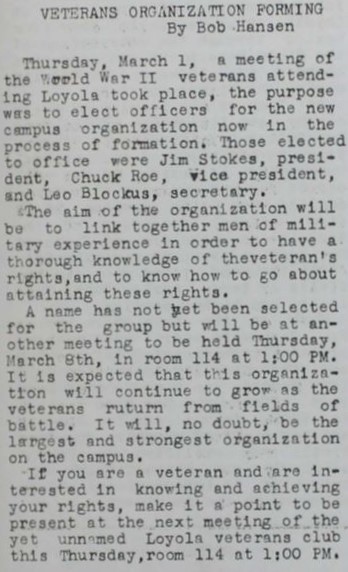
This article by Bob Hansen in the Loyola News describes a meeting on Thursday, March 1, 1945 to elect officers for the newly forming World War II veterans student group. The new officers were President Jim Stokes, Vice President Chuck Roe, and Secretary Leo Blockus. Their aim was "to link together men of military experience in order to have a thorough knowledge of the veteran's rights, and to know how to go about attaining these rights." The article continues:
"It is expected that this organization will continue to grow as the veterans return from fields of battle. It will, no doubt, be the largest and strongest organization on the campus.
If you are a veteran and are interested in knowing and achieving your rights, make it a point to be present at the next meeting of the yet unnamed Loyola veterans club this Thursday, room 114, at 1:00 PM."
-
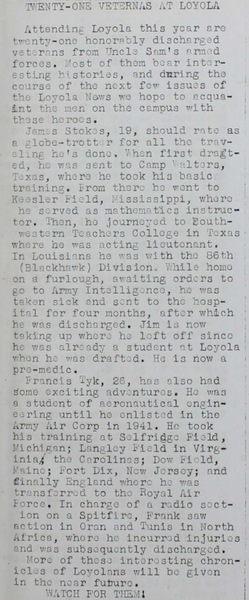
This article in the Loyola News describes some of the 21 "honorably discharged veterans from Uncle Sam's armed forces" attending Loyola in the Fall of 1944. The students featured here are James Stokes and Francis Tyk.
The first image is the full article. The second is a detail with the title and first paragraph.
-
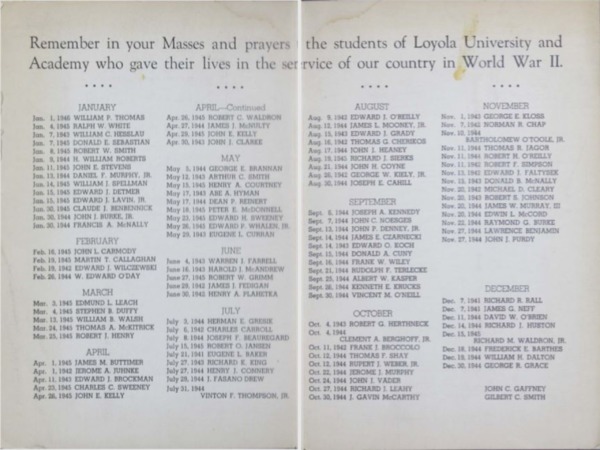
This collage of two facing pages in a WWII Memorial Program list the students of Loyola University Chicago and Loyola Academy who died in World War II. The program is part of the World War II scrapbook.
-
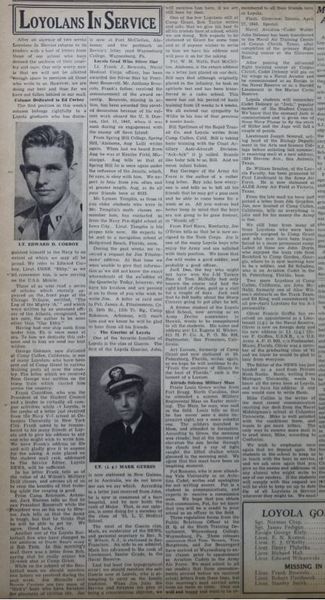
This article in the Loyola News gives profiles and updates on Loyola professors and students who are involved in World War II.
-
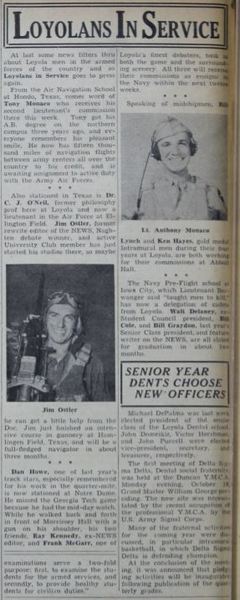
This article in the Loyola News gives profiles and updates on Loyola professors and students who are involved in World War II.
-
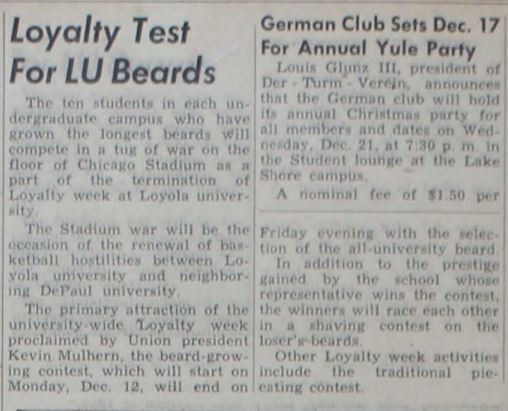
This article covers developments in a beard-growing contest among undergraduate students at Loyola during razor rationing during World War II.
"The ten students in each undergraduate campus who have grown the longest beards will compete in a tug of war on the floor of Chicago Stadium as part of the termination of Loyalty week at Loyola university.
The Stadium war will be the occasion of the renewal of basketball hostilities between Loyola and neighboring DePaul university.
The primary attraction of the university-wide Loyalty week proclaimed by Union president Kevin Mulhern, the beard-growing contest, which will start on Monday, Dec. 12, will end on Friday evening with the selection of the all-university beard.
In addition to the prestige gained by the school whose representative wins the contest, the winners will race each other in a shaving contest on the loser's eards.
Other Loyalty week activities include the traditional pie-eating contest."
-
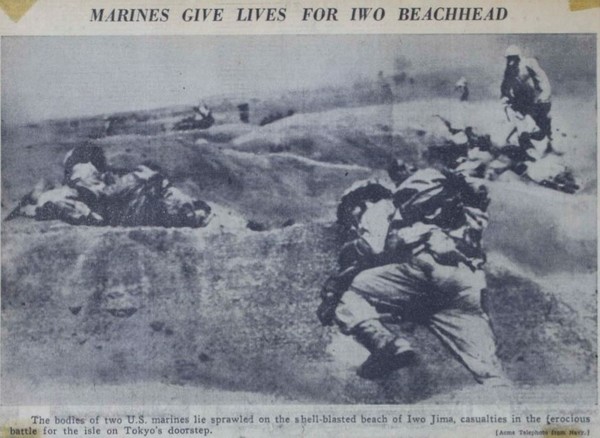
A photograph shows to U.S. marines killed on the beach of Iwo Jima during the marines' invasion of the island.
The caption reads:
"The bodies of two U.S. marines lie sprawled on the shell-blasted beach of Iwo Jima, casualties in the ferocious battle for the isle on Tokyo's doorstep."
-

This news clipping, written by Thomas Morrow of the Chicago Tribune Press Service, appears in the World War II scrapbook. It focuses on two Chicagoans, Lieutenants John B. Sackley Jr. and E. J. Calihan, who were "engaged in the work of directing naval guns from [Iwo Jima]." "Sackley and Calihan's careers parallel since they went to high school together. Both attended Loyola university and played on the basketball team together. Both enlisted in the armed guards in 1942. The ships both were escorting were attacked by plans and submarines, but both Sackley's and Calihan's ships came thru unscathed. Both men transferred out of the armed guards and into the navy in October, 1943, and both were assigned to naval gunfire ashore. They went into the Marianas [Marines?] together and had battalions side by side in the Marshalls. Each was assigned to a division in the present operation and they came ashore the same day. Their work calls for a daily conference, placing shells for the day."
-

This article from the Loyola News discusses a series of free lectures on cartography given by the Graduate School of Loyola University by Rev. Jean Delangles, S.J. at the downtown college in the afternoons of Wednesdays, April 7, 14, 28 and May 5, 19, and 26.
Cartography is described as being critical to how "the highest military and naval authorities of the country plan their campaigns and so execute them as to bring ultimate victory over our enemies." It also invokes the Roman legions' use of maps, and says that the airplane makes cartography important for "all educated Americans when peace comes. This is especially true for those living in the Chicago area, for the position of this city, as will be shown by Father Delangles, makes it an ideal place as a world center of air transport.
"Those instructors, who in response to government pleas, will devote their talents in the near future to the teaching of geography and map-making, as well as those already engaged along these lines, will find these lectures very profitable."
-
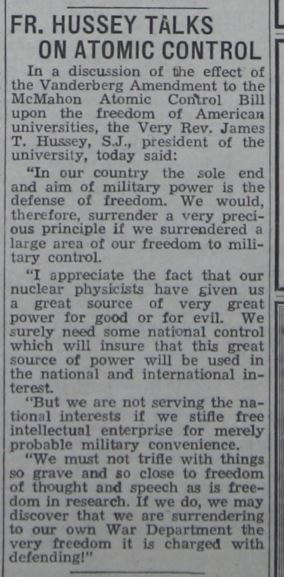
This Loyola News article discusses Rev. James t. Hussey, S.J.'s talk that day "on the effect of the Vandenberg Amendment to the McMahon Atomic Control Bill upon the freedom of American universities". The McMahon Atomic Control Bill came out of fears in 1945 that researchers might defect and give atomic secrets to enemy countries. Rev. Hussey was concerned about the restriction of academic freedom due to military power.
He is quoted: "In our country the sole end and aim of military power is the defense of freedom. We would, therefore, surrender a very precious principle if we surrendered a large area of our freedom to military control.
"I appreciate the fact that our nuclear physicists have given us a great source of very great power for good and for evil. We surely need some national control which will insure that this great source of power will be used in the nai=tional and international interest.
But we are not serving the national interests if we stifle free intellectual enterprise for merely probable military convenience.
"We must not trifle with things so grave and so close to freedom of thought and speech as is freedom in research. If we do, we may discover that we are surrendering to our own War Department the very freedom it is charged with defending!"
-
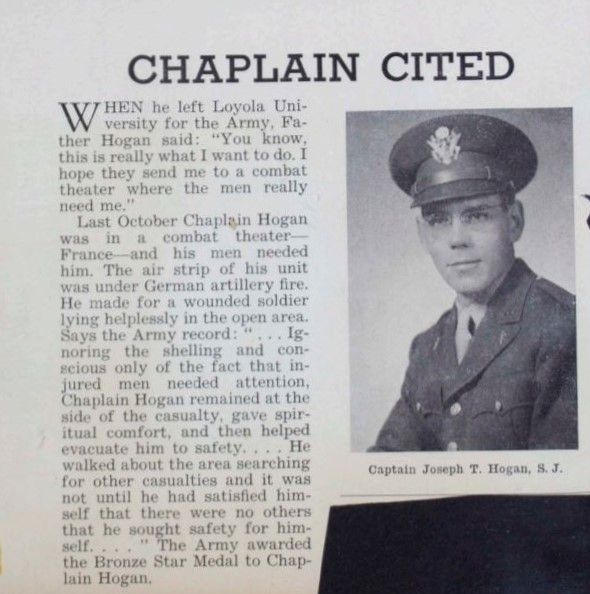
This clipping appears in the World War II scrapbook. The title, "Chaplain Cited," refers to Captain Joseph T. Hogan, S. J., whose photo is included with the article. Father Hogan left Loyola for the Army. While in France, under artillery fire, he ignored the shelling and rescued an injured soldier, "gave spiritual comfort, and then helped evacuate him to safety." He then only went to safety after making sure no one else was left behind. "The Army awarded the Bronze Star Medal to Chaplain Hogan."
-

This article, titled “Hero is Home, Parro Clan Marks Yule, Thanksgiving,” appears in the World War II scrapbook. It includes a photo of Captain Don Parro captioned "Hero Comes Home-- Capt. Don Parro 8133 Champlain av., veteran of 51 flight missions." Capt. Parro, age 23, had already piloted 51 missions over Italy and Africa. The article covers the family of Mrs. Genevieve Parro, whose six sons were all together again for the first time in two years. The other sons were in the air force, the Aviation Cadet Board, and one assigned "to the ASTP of the dental school at Loyola University." Two more sons, Vincent, 16, and William, 14, were students at Loyola Academy and hoping to enter the Air Forces.
-
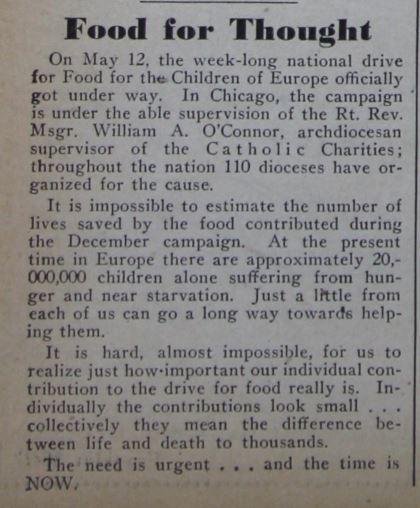
This newspaper clipping appears in the World War II scrapbook. Titled “Food for Thought,” it announces the "week-long national drive for Food for the Children of Europe" and who would supervise it in Chicago. It estimates that there were "approximately 20,000,000 children alone suffering from hunger and near starvation. Just a little from each of us can go a long way towards helping them."
-
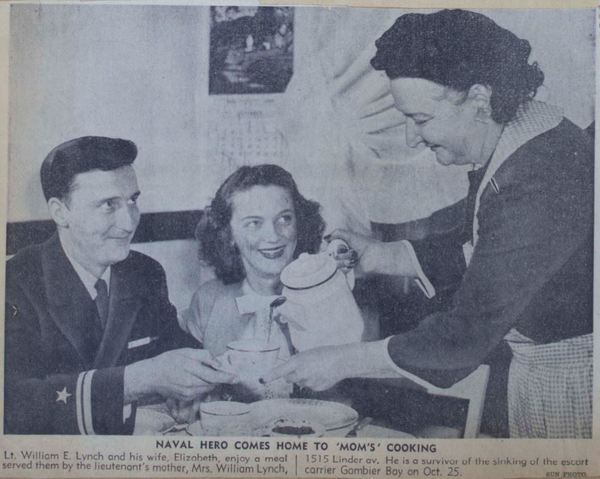
This newspaper clipping is found in the World War II scrapbook. The photo shows Lt. William E. Lynch and his wife Elizabeth, being served beverages in teacups by Mrs. William Lynch, Lt. Lynch's mother. The caption reads:
"Lt. William E. Lynch and his wife, Elizabeth, enjoy a meal served them by the lieutenant's mother, Mrs. William Lynch, 1515 Linder av. He is a survivor of the sinking of the escort carrier Gambier Bay on Oct. 25. Sun Photo"
-

The "In The Headlines" section of the Loyola News, by Bob Koenig, discusses "the subject of deferments in the draft law," which he says was on every draft registrant's mind to save "a year's time in the army." He discusses the rules for college students and categories of questions they will have to answer when applying for deferment.

























